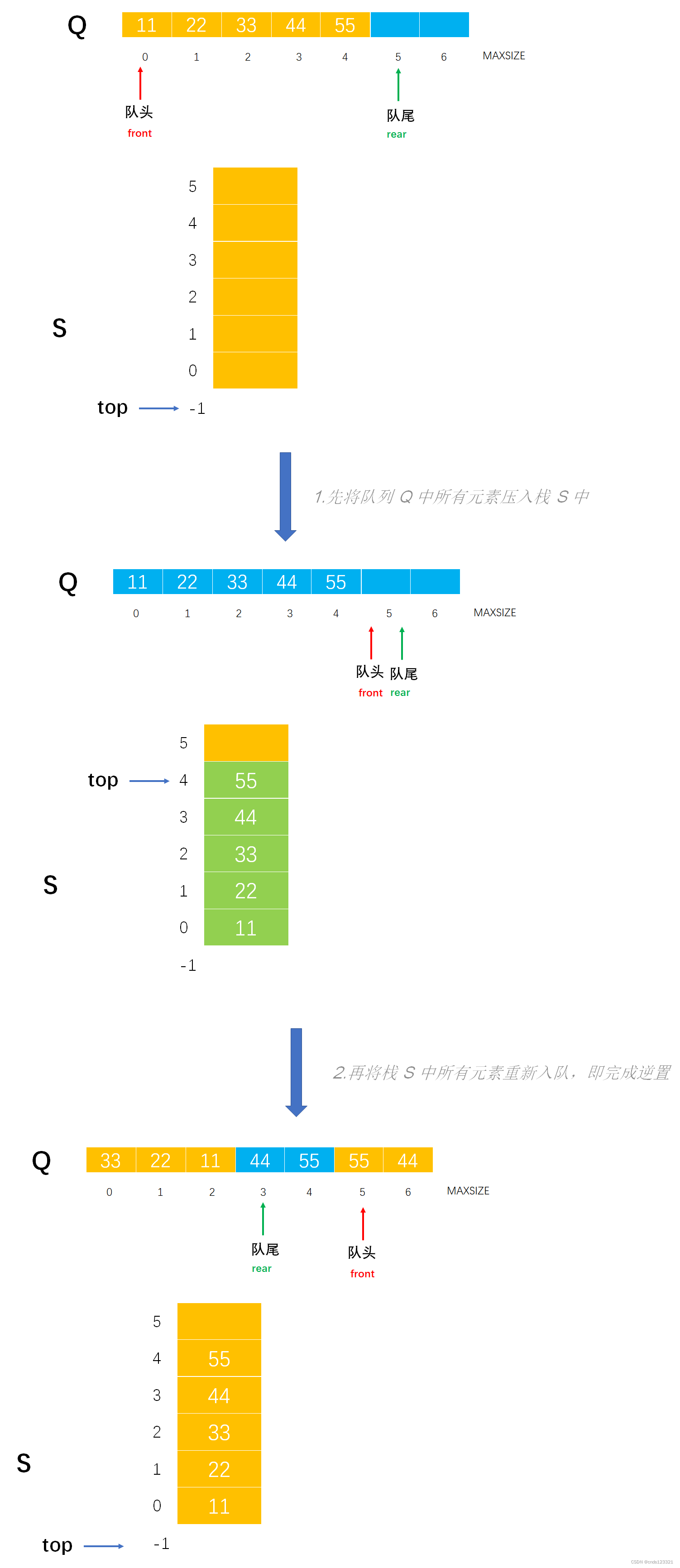Example005
题目
Q 是一个队列,S 是一个空栈,实现将队列中的元素逆置的算法。
分析
主要考查对队列和栈的特性与操作。由于对队列的一系列操作不可能将其中的元素全部逆置,而栈可以将入栈的元素逆序提取出来,因此我们可以让队列中的元素逐个出队列,一一入栈;全部入栈后再逐个入栈,一一入队列。
图解

C实现
核心代码:
/**
* 逆置队列中的所有元素,假设栈的空间足够大
* @param Q 装了元素的队列
* @param S 空栈
*/
void inversionQueue(SeqQueue *Q, SeqStack *S) {
// 1.先将队列 Q 中所有元素压入栈 S 中
while (!isEmptyQueue(*Q)) {// 如果队列不为空,则一直将元素出队
// 局部变量,记录出队元素
int ele;
// 将队头元素出队
deQueue(Q, &ele);
// 将队头元素压入栈中
push(S, ele);
}
// 2.再将栈 S 中所有元素重新入队,即完成逆置
while (!isEmptyStack(*S)) {// 如果栈不为空,则一直将元素出栈
// 局部变量,记录栈顶元素
int top;
// 将栈顶元素出栈
pop(S, &top);
// 再将栈顶元素入队
enQueue(Q, top);
}
}
完整代码:
/*
Q 是一个队列,S 是一个空栈,实现将队列中的元素逆置的算法。
*/
#include<stdio.h>
/**
* 顺序队列中能存储的最大元素个数
*/
#define QUEUE_MAXSIZE 10
/**
* 顺序队列结构体定义
*/
typedef struct {
/**
* 数据域,存储队列中的数据
*/
int data[QUEUE_MAXSIZE];
/**
* 指针域,队头指针。在空队列中,队头指针指向 0;在非空队列中,队头指针始终指向队头元素
*/
int front;
/**
* 指针域,队尾指针。在空队列中,队尾指针指向 0;在非空队列中,队尾指针始终指向队尾元素的下一位置
*/
int rear;
} SeqQueue;
/**
* 初始化顺序队列
* @param queue 未初始化的顺序队列
*/
void initQueue(SeqQueue *queue) {
// 初始化顺序队列,将队头指针和队尾指针都指向 0
// 有些实现中将队头指针和队尾指针指向 -1,这无所谓,只要能够实现队列功能即可
queue->front = 0;
queue->rear = 0;
}
/**
* 判断顺序队列是否为空
* @param queue 顺序队列
* @return 如果顺序队列为空则返回 1,否则返回 0 表示非空队列
*/
int isEmptyQueue(SeqQueue queue) {
// 如果队头指针和队尾指针都指向同一位置,则表示队列处于空
// 因为队头指针和队尾指针在不断变化,只要它们相等就表示是空队列,其中 front 和 rear 可能是 0,有可能是 4,而非一直都初始化值
if (queue.front == queue.rear) {
return 1;
} else {
return 0;
}
}
/**
* 将元素入队,即插入到队尾
* @param queue 顺序队列
* @param ele 待入队的元素
* @return 如果入队成功则返回 1,否则返回 0 表示入队失败
*/
int enQueue(SeqQueue *queue, int ele) {
// 0.参数校验,如果队满,则不能入队
if (queue->rear == QUEUE_MAXSIZE) {
return 0;
}
// 1.将元素入队
// 1.1 先进行赋值,初始时队头指针指向 0
queue->data[queue->rear] = ele;
// 1.2 然后将队尾指针加一
queue->rear++;
// 1.3 返回 1 表示入队成功
return 1;
}
/**
* 将元素出队,即出队队头元素
* @param queue 顺序队列
* @param ele 用来保存出队元素
* @return 如果出队成功则返回 1,否则返回 0 表示出队失败
*/
int deQueue(SeqQueue *queue, int *ele) {
// 0.参数校验,如果队空则不能出队
if (queue->front == queue->rear) {
return 0;
}
// 1.将元素出队
// 1.1 用 ele 保存队头元素
*ele = queue->data[queue->front];
// 1.2 将队头指针加一,表示删除队头元素,使得队头指针始终指向队头元素
queue->front++;
// 1.3 返回 1 表示出队成功
return 1;
}
/**
* 打印顺序队列中从队头到队尾的所有元素
* @param queue 顺序队列
*/
void printQueue(SeqQueue queue) {
printf("[");
for (int i = queue.front; i < queue.rear; i++) {
printf("%d", queue.data[i]);
if (i != queue.rear - 1) {
printf(", ");
}
}
printf("]\n");
}
/**
* 顺序栈最大存储的元素个数
*/
#define STACK_MAXSIZE 100
/**
* 顺序栈结构体定义
*/
typedef struct {
/**
* 数据域,数组,用来存储栈中元素
*/
int data[STACK_MAXSIZE];
/**
* 指针域,表示栈顶指针,实际上就是数组下标
*/
int top;
} SeqStack;
/**
* 初始化顺序栈,即将栈顶指针指向 -1 表示空栈
* @param stack 顺序栈
*/
void initStack(SeqStack *stack) {
// 设定让栈顶指针指向 -1 表示为栈空
stack->top = -1;
}
/**
* 判断顺序栈是否为空
* @param stack 顺序栈
* @return 如果顺序栈为空则返回 1,否则返回 0
*/
int isEmptyStack(SeqStack stack) {
// 只需要判断栈顶指针是否等于 -1 即可,如果是空栈则返回 1,不是空栈则返回 0
if (stack.top == -1) {
return 1;
} else {
return 0;
}
}
/**
* 将元素入栈
* @param stack 顺序栈
* @param ele 元素值
* @return 如果栈满则返回 0 表示入栈失败;如果插入成功则返回 1
*/
int push(SeqStack *stack, int ele) {
// 1.参数校验,如果栈满则不能入栈元素
if (stack->top == STACK_MAXSIZE - 1) {
// 如果栈满,则返回 0,表示不能入栈
return 0;
}
// 2.先将栈顶指针加一,指向新空数组位置
stack->top++;
// 3.将新元素值填充到新位置中
stack->data[stack->top] = ele;
return 1;
}
/**
* 将元素出栈
* @param stack 顺序栈
* @param ele 用来保存出栈的元素
* @return 如果栈空则返回 0 表示出栈失败;否则返回 1 表示出栈成功
*/
int pop(SeqStack *stack, int *ele) {
// 1.参数校验,栈空不能出栈
if (stack->top == -1) {
// 栈空,没有元素可出栈
return 0;
}
// 2.用 ele 来保存顺序栈栈顶元素
*ele = stack->data[stack->top];
// 3.然后栈顶指针减一,表示出栈一个元素
stack->top--;
return 1;
}
/**
* 逆置队列中的所有元素,假设栈的空间足够大
* @param Q 装了元素的队列
* @param S 空栈
*/
void inversionQueue(SeqQueue *Q, SeqStack *S) {
// 1.先将队列 Q 中所有元素压入栈 S 中
while (!isEmptyQueue(*Q)) {// 如果队列不为空,则一直将元素出队
// 局部变量,记录出队元素
int ele;
// 将队头元素出队
deQueue(Q, &ele);
// 将队头元素压入栈中
push(S, ele);
}
// 2.再将栈 S 中所有元素重新入队,即完成逆置
while (!isEmptyStack(*S)) {// 如果栈不为空,则一直将元素出栈
// 局部变量,记录栈顶元素
int top;
// 将栈顶元素出栈
pop(S, &top);
// 再将栈顶元素入队
enQueue(Q, top);
}
}
int main() {
// 声明一个队列并初始化
SeqQueue queue;
initQueue(&queue);
// 为队列添加一些测试数据
enQueue(&queue, 11);
enQueue(&queue, 22);
enQueue(&queue, 33);
enQueue(&queue, 44);
enQueue(&queue, 55);
// 声明一个栈并初始化为空栈
SeqStack stack;
initStack(&stack);
// 打印逆置前的队列
printQueue(queue);
// 调用函数逆置队列元素
inversionQueue(&queue, &stack);
// 打印逆置后的队列
printQueue(queue);
}
执行结果:
[11, 22, 33, 44, 55]
[55, 44, 33, 22, 11]
Java实现
核心代码:
/**
* 逆置队列
*
* @param Q 队列
* @param S 空栈
* @throws Exception 如果顺序栈已满再入栈则会抛出异常
*/
public static void inversionQueue(CircularQueue Q, SeqStack S) throws Exception {
// 1.先将队列 Q 中所有元素压入栈 S 中
while (!Q.isEmpty()) {// 如果队列不为空,则一直将元素出队
// 局部变量,记录出队元素
int ele;
// 将队头元素出队
ele = Q.deQueue();
// 将队头元素压入栈中
S.push(ele);
}
// 2.再将栈 S 中所有元素重新入队,即完成逆置
while (!S.isEmpty()) {// 如果栈不为空,则一直将元素出栈
// 局部变量,记录栈顶元素
int top;
// 将栈顶元素出栈
top = S.pop();
// 再将栈顶元素入队
Q.enQueue(top);
}
}
完整代码:
public class Test {
public static void main(String[] args) throws Exception {
// 声明一个队列并初始化
CircularQueue queue = new CircularQueue();
queue.init();
// 为队列添加一些测试数据
queue.enQueue(11);
queue.enQueue(22);
queue.enQueue(33);
queue.enQueue(44);
queue.enQueue(55);
// 声明一个栈并初始化为空栈
SeqStack stack = new SeqStack();
stack.init();
// 打印逆置前的队列
queue.print();
// 调用函数逆置队列元素
inversionQueue(queue, stack);
// 打印逆置后的队列
queue.print();
}
/**
* 逆置队列
*
* @param Q 队列
* @param S 空栈
* @throws Exception 如果顺序栈已满再入栈则会抛出异常
*/
public static void inversionQueue(CircularQueue Q, SeqStack S) throws Exception {
// 1.先将队列 Q 中所有元素压入栈 S 中
while (!Q.isEmpty()) {// 如果队列不为空,则一直将元素出队
// 局部变量,记录出队元素
int ele;
// 将队头元素出队
ele = Q.deQueue();
// 将队头元素压入栈中
S.push(ele);
}
// 2.再将栈 S 中所有元素重新入队,即完成逆置
while (!S.isEmpty()) {// 如果栈不为空,则一直将元素出栈
// 局部变量,记录栈顶元素
int top;
// 将栈顶元素出栈
top = S.pop();
// 再将栈顶元素入队
Q.enQueue(top);
}
}
}
CircularQueue:
public class CircularQueue {
/**
* 循环队列中能存储的最大元素个数
*/
private final int MAXSIZE = 7;
/**
* 声明循环队列
*/
private Queue queue;
/**
* 初始化循环队列
*/
public void init() {
queue = new Queue();
// 为数据域分配存储空间
queue.data = new int[MAXSIZE];
// 循环队列初始时,队头指针和队尾指针仍然都指向 0,表示是空队列
queue.front = 0;
queue.rear = 0;
}
/**
* 判断循环队列是否为空
*
* @return 如果循环队列为空则返回 true,否则返回 false 表示非空
*/
public boolean isEmpty() {
// 只要队头指针和队尾指针相等,那么表示循环队列为空,无论指针在哪个位置
return queue.rear == queue.front;
}
/**
* 判断循环队列是否已满
*
* @return 如果循环队列已满则返回 true,否则返回 false 表示队列非满
*/
public boolean isFull() {
// 队尾指针再加上一,然后对 MAXSIZE 取余,如果等于队头指针,那么表示队满
return (queue.rear + 1) % MAXSIZE == queue.front;
}
/**
* 将元素入队
*
* @param ele 指定元素
* @throws Exception 如果循环队列已满则不能入队,则抛出此异常
*/
public void enQueue(int ele) throws Exception {
// 0.参数校验,如果队满则不能入队
if (isFull()) {
throw new Exception("队列已满不能入队!");
}
// 1.将元素入队
// 1.1 先进行赋值,即将新元素填充到队尾指针指向的位置。因为队尾指针指向队尾元素的下一个位置
queue.data[queue.rear] = ele;
// 1.2 然后将队尾指针加一。因为是循环队列,如果到了队尾,那么又要从 0 开始,所以加一后需要对 MAXSIZE 进行取余
queue.rear = (queue.rear + 1) % MAXSIZE;
}
/**
* 将元素出队
*
* @return 出队的元素
* @throws Exception 如果队空则不能出队,则抛出此异常
*/
public int deQueue() throws Exception {
// 0.参数校验,如果队空则不能出队
if (isEmpty()) {
throw new Exception("队列为空不能出队!");
}
// 1.将队头元素出队
// 1.1 用 ele 保存队头指针所指向的元素
int front = queue.data[queue.front];
// 1.2 将队头指针加一,表示删除队头元素。因为是循环队列,所以要对 MAXSIZE 取余
queue.front = (queue.front + 1) % MAXSIZE;
// 1.3 返回队头元素
return front;
}
/**
* 获取循环队列中的元素个数
*
* @return 队列中的元素个数
*/
public int size() {
// 如果是顺序队列,则元素个数是 rear-front
// 如果是循环队列,则元素个数是 (rear-front+MAXSIZE)%MAXSIZE
return (queue.rear - queue.front + MAXSIZE) % MAXSIZE;
}
/**
* 获取循环队列的队头元素
*
* @return 循环队列的队头元素
* @throws Exception 如果队列为空则抛出此异常
*/
public int getFront() throws Exception {
// 0.参数校验,如果队列为空则没有队头元素,自然无法获取,所以抛出异常表示获取失败
if (isEmpty()) {
throw new Exception("队空不能获取队头元素!");
}
// 1.返回队头元素,即队头指针所指向的元素
return queue.data[queue.front];
}
/**
* 获取循环队列中的队尾元素
*
* @return 循环队列的队尾元素
* @throws Exception 如果队列为空则抛出此异常
*/
public int getRear() throws Exception {
// 0.参数校验,如果队列为空则没有队尾元素,自然无法获取,所以抛出此异常表示获取失败
if (isEmpty()) {
throw new Exception("队空不能获取队尾元素!");
}
// 1.返回队尾元素,由于队尾指针指向队尾元素的下一个位置,所以要队尾指针减一
return queue.data[(queue.rear - 1 + MAXSIZE) % MAXSIZE];
}
/**
* 清空循环队列
*/
public void clear() {
// 即将队头指针和队尾指针都指向 0,表示恢复循环队列的初始状态,即空表
queue.front = 0;
queue.rear = 0;
}
/**
* 打印循环队列中从队头到队尾的所有元素
*/
public void print() {
System.out.print("[");
int front = queue.front;
while (front != queue.rear) {
System.out.print(queue.data[front]);
if (front != (queue.rear - 1 + MAXSIZE) % MAXSIZE) {
System.out.print(", ");
}
front = (front + 1) % MAXSIZE;
}
System.out.print("]\n");
}
}
/**
* 循环队列定义
*/
class Queue {
/**
* 数据域,存储循环队列中的数据
*/
int[] data;
/**
* 指针域,存储循环队列中队头元素的位置
*/
int front;
/**
* 指针域,存储循环队列中队尾元素的位置
*/
int rear;
}
SeqStack:
public class SeqStack {
/**
* 常量,顺序栈所能容纳的最大元素个数
*/
private final int MAXSIZE = 100;
/**
* 声明一个顺序栈
*/
private Stack stack;
/**
* 初始化顺序栈
*/
public void init() {
// 实例化栈对象
stack = new Stack();
// 为数据域分配空间
stack.data = new int[MAXSIZE];
// 将顺序栈的栈顶指针指向 -1 表示空栈
stack.top = -1;
}
/**
* 判断顺序栈是否为空
*
* @return 如果顺序栈为空则返回 true,否则返回 false
*/
public boolean isEmpty() {
// 规定了 -1 表示空栈,所以只需要判断栈顶指针是否等于 -1 即可
return stack.top == -1;
}
/**
* 将指定元素入栈
*
* @param ele 指定元素
* @throws Exception 如果栈满则不能入栈,抛出此异常
*/
public void push(int ele) throws Exception {
// 1.参数校验,如果栈满则不能入栈,抛出异常
if (stack.top == MAXSIZE - 1) {// 因为栈顶指针 top 存储的是数组下标,所以判断是否等于 MAXSIZE-1
throw new Exception("栈已满,不能再插入!");
}
// 2.先栈顶指针加 1,因为原栈顶指针处已经存储了元素,所以加一指向新的空位置
stack.top++;
// 3.在新的空位置处插入新元素,即为指定下标的数组元素赋值
stack.data[stack.top] = ele;
}
/**
* 将栈顶元素出栈
*
* @return 栈顶元素
* @throws Exception 如果栈空则不能出栈,抛出此异常
*/
public int pop() throws Exception {
// 1.参数校验,如果栈空则不能出栈,抛出异常
if (stack.top == -1) {// 因为栈空的定义是栈顶指针为 -1,所以如果栈顶指针为 -1 那么就是空栈,就不能出栈元素
throw new Exception("栈为空,不能出栈元素!");
}
// 2.记录栈顶元素,因为要将该元素返回,即要出栈的元素
int result = stack.data[stack.top];
// 3.栈顶指针减一,因为原栈顶元素已经出栈了,栈中元素个数减一
stack.top--;
return result;
}
/**
* 获取栈顶元素,但不出栈
*
* @return 栈顶元素
* @throws Exception 如果栈空则不能出栈,抛出此异常
*/
public int getTop() throws Exception {
// 1.参数校验,如果栈空则不能出栈,抛出异常
if (stack.top == -1) {
throw new Exception("栈为空,不能获取栈顶元素!");
}
// 2.直接返回栈顶元素,但不出栈
return stack.data[stack.top];
}
/**
* 顺序栈中元素个数
*
* @return 栈中元素个数
*/
public int size() {
// top 表示栈顶指针,实际上就是数组 data 的下标,所以实际元素个数就是下标加一
// 即使是空栈 top=-1,那么最后也会返回 0 表示元素个数为零个
return stack.top + 1;
}
/**
* 打印顺序栈中所有元素,从栈顶到栈底
*/
public void print() {
System.out.print("[");
for (int i = stack.top; i >= 0; i--) {
if (i != stack.top) {
System.out.print(", ");
}
System.out.print(stack.data[i]);
}
System.out.print("]\n");
}
/**
* 清空顺序栈
*/
public void clear() {
// 直接将栈顶指针指向 -1 即可表示空栈,不用重置栈中已有元素的值,因为顺序栈操作只跟栈顶指针有关
stack.top = -1;
}
}
/**
* 栈定义
*/
class Stack {
/**
* 顺序栈用来存储元素的数组
*/
int[] data;
/**
* 记录顺序栈的栈顶指针,即数组下标
*/
int top;
}
执行结果:
[11, 22, 33, 44, 55]
[55, 44, 33, 22, 11]
